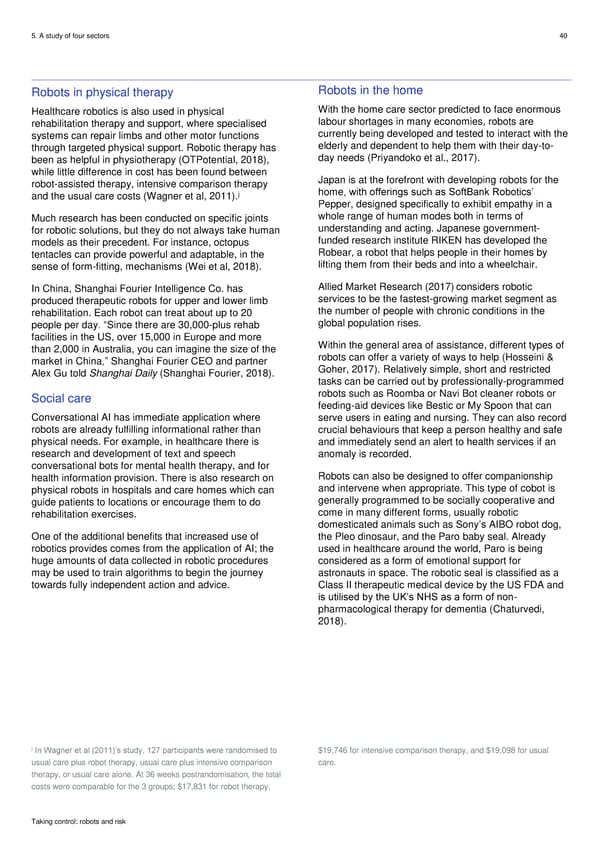5. A study of four sectors 40 Robots in physical therapy Robots in the home Healthcare robotics is also used in physical With the home care sector predicted to face enormous rehabilitation therapy and support, where specialised labour shortages in many economies, robots are systems can repair limbs and other motor functions currently being developed and tested to interact with the through targeted physical support. Robotic therapy has elderly and dependent to help them with their day-to- been as helpful in physiotherapy (OTPotential, 2018), day needs (Priyandoko et al., 2017). while little difference in cost has been found between Japan is at the forefront with developing robots for the robot-assisted therapy, intensive comparison therapy home, with offerings such as SoftBank Robotics’ and the usual care costs (Wagner et al, 2011).j Pepper, designed specifically to exhibit empathy in a Much research has been conducted on specific joints whole range of human modes both in terms of for robotic solutions, but they do not always take human understanding and acting. Japanese government- models as their precedent. For instance, octopus funded research institute RIKEN has developed the tentacles can provide powerful and adaptable, in the Robear, a robot that helps people in their homes by sense of form-fitting, mechanisms (Wei et al, 2018). lifting them from their beds and into a wheelchair. In China, Shanghai Fourier Intelligence Co. has Allied Market Research (2017)considers robotic produced therapeutic robots for upper and lower limb services to be the fastest-growing market segment as rehabilitation. Each robot can treat about up to 20 the number of people with chronic conditions in the people per day. “Since there are 30,000-plus rehab global population rises. facilities in the US, over 15,000 in Europe and more Within the general area of assistance, different types of than 2,000 in Australia, you can imagine the size of the robots can offer a variety of ways to help (Hosseini & market in China,” Shanghai Fourier CEO and partner Goher, 2017). Relatively simple, short and restricted Alex Gu told Shanghai Daily (Shanghai Fourier, 2018). tasks can be carried out by professionally-programmed Social care robots such as Roomba or Navi Bot cleaner robots or feeding-aid devices like Bestic or My Spoon that can Conversational AI has immediate application where serve users in eating and nursing. They can also record robots are already fulfilling informational rather than crucial behaviours that keep a person healthy and safe physical needs. For example, in healthcare there is and immediately send an alert to health services if an research and development of text and speech anomaly is recorded. conversational bots for mental health therapy, and for Robots can also be designed to offer companionship health information provision. There is also research on and intervene when appropriate. This type of cobot is physical robots in hospitals and care homes which can generally programmed to be socially cooperative and guide patients to locations or encourage them to do come in many different forms, usually robotic rehabilitation exercises. domesticated animals such as Sony’s AIBO robot dog, One of the additional benefits that increased use of the Pleo dinosaur, and the Paro baby seal. Already robotics provides comes from the application of AI; the used in healthcare around the world, Paro is being huge amounts of data collected in robotic procedures considered as a form of emotional support for may be used to train algorithms to begin the journey astronauts in space. The robotic seal is classified as a towards fully independent action and advice. Class II therapeutic medical device by the US FDA and is utilised by the UK’s NHS as a form of non- pharmacological therapy for dementia (Chaturvedi, 2018). j In Wagner et al (2011)’s study, 127 participants were randomised to $19,746 for intensive comparison therapy, and $19,098 for usual usual care plus robot therapy, usual care plus intensive comparison care. therapy, or usual care alone. At 36 weeks postrandomisation, the total costs were comparable for the 3 groups; $17,831 for robot therapy, Taking control: robots and risk
 Robots & Risk Page 39 Page 41
Robots & Risk Page 39 Page 41